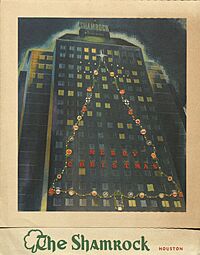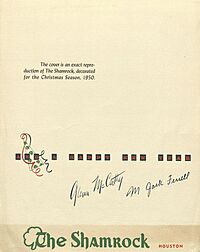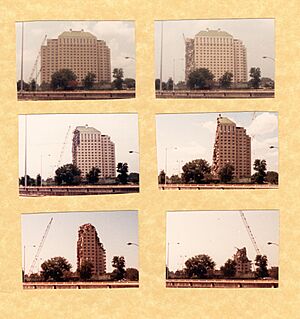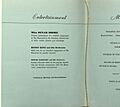Shamrock Hotel facts for kids
Quick facts for kids Shamrock Hotel |
|
|---|---|
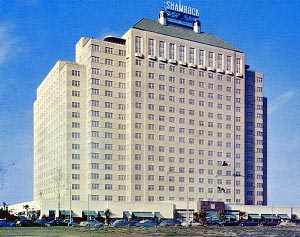
On what was the edge of countryside south of Houston, Texas in 1949, shortly after construction.
|
|
| Hotel chain | Hilton Hotels & Resorts |
| General information | |
| Status | Demolished |
| Type | Hotel |
| Location | Main St. & W. Holcombe Blvd., Houston, TX 77030, United States |
| Opening | March 17, 1949 |
| Closed | June 1986 |
| Demolished | June 1, 1987 |
| Owner | Glenn McCarthy Pat O'Brien |
| Technical details | |
| Floor count | 18 |
| Design and construction | |
| Architect | Wyatt C. Hedrick |
| Other information | |
| Number of rooms | 1,100 |
| Number of restaurants | 3 |
The Shamrock Hotel was a famous hotel built in Houston, Texas. It was constructed between 1946 and 1949 by a businessman named Glenn McCarthy. At the time, it was the largest hotel built in the United States during the 1940s.
The hotel's grand opening was a huge party. Many people still remember it as one of the biggest social events ever in Houston. In 1955, the hotel was sold to Hilton Hotels. It then became known as the Shamrock Hilton for over 30 years. The hotel faced money problems throughout its history. In 1985, Hilton Hotels gave the building to the Texas Medical Center. The Shamrock Hotel was torn down on June 1, 1987.
Contents
Building the Shamrock Hotel
The Shamrock Hotel was designed by an architect named Wyatt C. Hedrick. It was an eighteen-story building. It had a green tile roof and 1,100 rooms. Glenn McCarthy wanted it to be a huge hotel for big meetings and conventions. He also wanted it to feel like a fun resort.
The hotel was built a bit outside downtown Houston. It was about three miles (5 km) southwest of the city center. This area was mostly countryside back then. McCarthy planned for it to be the first part of a much bigger shopping and entertainment area. This area was called McCarthy Center. It was meant to be next to the planned Texas Medical Center.
On the north side of the hotel, there was a five-story building. This building had a garage for 1,000 cars. It also had a large exhibition hall. This hall was about 25,000 square feet (2,300 m2).
To the south, there was a beautiful garden. It was designed by Ralph Ellis Gunn. There was also a huge swimming pool. It measured 165 feet (50 m) by 142 feet (43 m). People called it the world's biggest outdoor pool. It was even used for water skiing shows. It had a tall, three-story diving platform with a spiral staircase.
The hotel cost about $21 million to build. This would be over $200 million today.
Some people warned McCarthy that business travelers might not want to stay so far from downtown. Hotel experts also said the project might not make money. McCarthy replied, "I went into the oil business in 1933 when everybody said I was a fool. Now they're saying it again about my hotel."
The hotel's lobby was very big, about 5,000 square feet (460 m2). It had shiny wood panels. The design was influenced by Art Deco style. This style was popular in the 1920s and 30s. McCarthy chose furniture and decorations in 63 different shades of green. This was a nod to his Irish heritage.
Some people, like famous architect Frank Lloyd Wright, criticized the design. Wright called it "an imitation Rockefeller Center". McCarthy believed the decor showed "the best of all periods."
The Grand Opening Party
The Shamrock Hotel officially opened on St. Patrick’s Day in 1949. There were fireworks displays. Two thousand people from Houston paid $42 each to have dinner. This party was called "Houston’s biggest party." It cost about one million dollars.
Over 150 Hollywood celebrities came to the party. These included Ginger Rogers and Errol Flynn. Many business leaders and reporters from Los Angeles also attended. Some were flown in on a special airplane McCarthy had bought. Others arrived by train.
An estimated 50,000 people gathered outside the hotel. Newspaper boys in fancy clothes handed out special editions of the Houston Post. The party became very crowded inside. Three thousand people were in the public areas. This was a thousand more than expected. Houston mayor Oscar F. Holcombe and his wife had to sit in a hallway. His chair was taken by someone else. He later said it was "the worst mob scene I have ever witnessed."
A local newspaper called the event "bedlam in diamonds." Life magazine said it was "...the most dazzling exhibition of evening dresses and big names ever seen in Texas." Everyone agreed it was a huge party and a wonderful hotel. The Shamrock's grand opening is still known as one of the biggest social events in Houston’s history.
How the Hotel Operated
The Shamrock Hotel started with 1,200 staff members. George Lindholm, who came from the famous Waldorf-Astoria hotel in New York, managed them. There were 23 different uniforms for employees. Guests signed in with green ink. Bellhops in green and yellow uniforms carried luggage.
The rooms were air-conditioned and also had green colors. They had modern art on the walls. They also had push-button radios and televisions. These were quite rare in hotels at that time. More than a third of the rooms had small kitchens. Famous singers performed in the hotel's nightclub, called the Emerald Room.
From 1949 to 1953, the Shamrock hosted a radio show. It was called Saturday at the Shamrock. This show was broadcast across the country by ABC. It was the only national radio show made outside New York or Los Angeles.
However, the Shamrock often had trouble filling its rooms. McCarthy had spent a lot of money. He also borrowed heavily against his property, including the hotel. His money quickly ran out. Within a year, the manager, Lindholm, left. In 1952, McCarthy couldn't pay back a loan. The hotel was then taken over by a company called Equitable Life Assurance Society.
Even with money problems, the Shamrock was a popular place. It had restaurants, bars, and fancy shops. People called it "Houston's Riviera" in the early 1950s. The hotel's private Cork Club was known for business deals. Singer Frank Sinatra also performed there.
The Shamrock Hilton Era
In 1954, the Hilton Hotels Corporation started managing the hotel. In 1955, Hilton bought the property. But Hilton also found it hard to make the huge hotel profitable. The hotel was far from downtown Houston. It was also far from the city's growing network of highways.
Also, many smaller, cheaper motels were opening. These motels were easier for people with cars. In 1957, a two-story motel-style building was added next to the swimming pool.
The planned shopping and entertainment center was never built. However, McCarthy's idea influenced the successful Houston Galleria. This large mall opened in 1970. Around 1965, the first Trader Vic's restaurant in Texas opened at the Shamrock. It stayed there until after 1985.
The hotel remained popular for social events in Houston. These included fancy parties for young women and business meetings. It continued as the Shamrock Hilton until 1986. By then, its local fame had faded.
The Hotel is Torn Down
In 1985, Houston was going through a tough economic time. The 36-year-old hotel was still the second largest in Houston. But it needed a lot of repairs and updates. It was given to the Texas Medical Center.
In March 1986, people who wanted to save old buildings held a protest. Glenn McCarthy, who built the hotel, was there. The hotel held its last annual St. Patrick's Day party for the public. That evening, some people who had been at the opening party in 1949 came back. A few employees had worked at the hotel since it first opened.
The main hotel building was torn down on June 1, 1987. Glenn McCarthy passed away 18 months later. The land where the hotel stood was paved over. It became a parking lot.
What's There Now
The Albert B. Alkek Institute of Biosciences and Technology Building was built in 1992. It stands on what used to be the hotel's north gardens. This building is part of the Texas A&M Health Science Center.
In 2017, the $67 million DeBakey High School for Health Professions was built. It stands on the exact spot where the hotel used to be.
Some fountains and landscaping from the hotel's northeast grounds are still there. The hotel's multi-story parking garage was also kept. However, its famous green roof tiles have been removed. Shamrock Drive, the street in front of the hotel, is now called Pressler Street.
Programs and Menus
See also
- History of Houston
- Architecture of Houston


